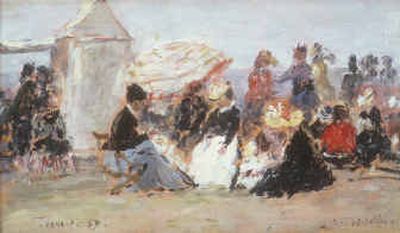Lasting Impressionists

Maybe it’s the glimpses of ordinary life in a quieter time, or the visible brush strokes of the artist, or the capturing of light filtering through a window – whatever it is, people are enchanted by Impressionist paintings.
Beginning Sunday is a rare opportunity to see the real thing, not a series of knock-off calendar prints.
Opening in the Northwest Museum of Arts and Culture is an exhibition of 29 works by 15 of the best-known artists of the 19th and 20th centuries.
“An Impressionist Eye: Painting and Sculpture from the Philip and Janice Levin Foundation” will be on display through May 15 in Gallery C.
“In most people’s eyes, there has been nothing of this high caliber seen in this area since the 1941 Vincent van Gogh exhibition,” says museum art curator Jochen Wierich.
The MAC is the fifth American museum to receive this show. The national tour of this exhibition is organized by the American Federation of Arts.
All of the paintings and sculptures in the exhibition at one time decorated the New York City apartment of philanthropists Philip and Janice H. Levin.
“Most of the works are relatively small in scale that fit perfectly into the Levins’ Fifth Avenue apartment,” says Wierich. “They are not grand, expansive works. This collection is very intimate, very personal.”
The Levins were particularly drawn to figurative art and selected items created by French artists, or artists working in France, during the late 19th and early 20th centuries.
“This show gives a contained and compressed history of modern art,” says Wierich, “and Impressionism is an important part of that story.”
The earliest work on view is Camille Corot’s “Portrait of a Girl,” painted around 1841.
Corot and Eugene Boudin were among the artists that helped establish some of the methods and fundamental concepts of Impressionism – working directly from nature and capturing the light.
Boudin’s view of the seaside town of Trouville along France’s Normandy coast is included in the show.
By the middle of the 19th century paint was being mass produced and was available in collapsible metal tubes, making oil paint easier to store, dispense and carry about, wrote Jonathan Stephenson in “Paint with the Impressionists.”
“Impressionism could not have happened if these changes had not taken place,” said Stephenson.
The exhibit features three groups of popular Impressionist subject matter: images of women, domestic scenes and still lifes, and leisure and country scenes.
There are women in formal poses, such as Mary Cassatt’s young woman with a handkerchief and Amedeo Modigliani’s head of a woman; interior scenes by Berthe Morisot and Édouard Vuillard; and Henri de Toulouse-Lautrec’s country outing.
One of the most popular works on view is “Chrysanthemums,” a still life of dazzling pink and red chrysanthemums by Claude Monet.
There are also four sculptures in the exhibition: two dancers stretching by Edgar Degas; “Head of a Jester” (cast ca. 1925 after composition of 1905) by Pablo Picasso; and “Bust of Diego” (cast ca. 1981 after composition of 1954) by Alberto Giacometti.
Degas’ two bronzes, as well as the Giacometti piece, were cast after the artists’ deaths.
Degas’ “Dancer Putting on a Stocking” (ca. 1896-1911) and “Dancer Holding Her Right Leg with Her Right Hand” (ca. 1882-95) were both cast in 1919-21 after wax-and-wire originals.
Degas was known to create small wax figures as models for his paintings and drawings.
“He might have looked at them as studies,” says Wierich. “The fact that they were cast after he died doesn’t make them less original.”